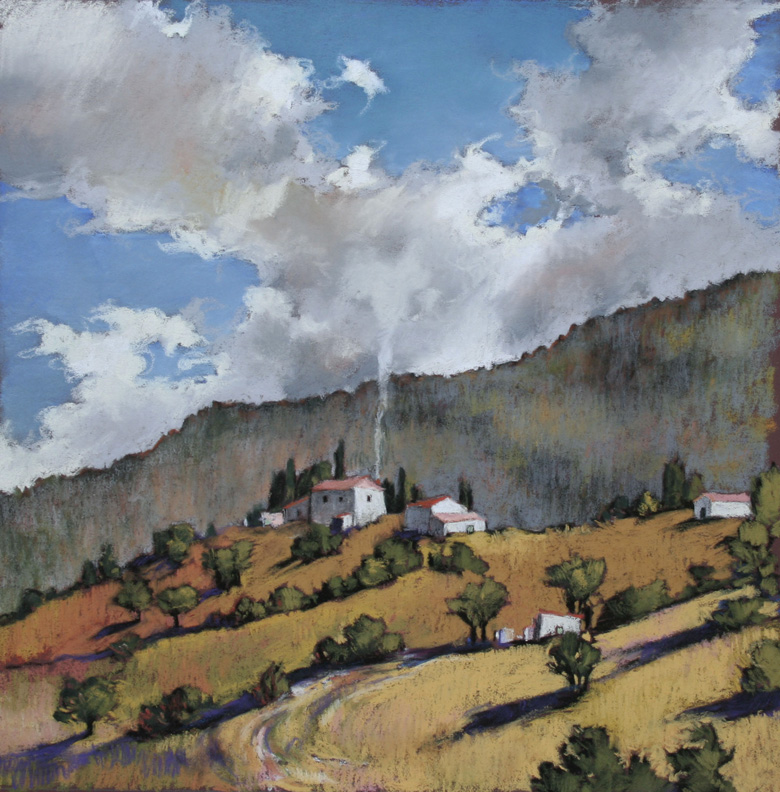Sometimes things happen in different places, for different reasons, and move inexorably along an invisible line toward an unexpected conclusion. We had this experience, with a horse, and a dog, and two open gates, far distant from each other.
Buster was our first Maremma sheepdog, a large, sweet-smelling snowball of an animal, who was maturing, healthily, towards his retirement. He was an excellent guard dog, most of the time, but if there were female pheromones in the air he could climb an eight foot fence as if he were Spiderman. Always attentive to any changes in his surroundings, we counted on him to alert us to arrivals, especially those people, animals, or automobiles that were not included in his repertoire of acceptable objects. We were his flock.
My son attended an elementary school far from here, on the opposite side of town. It was the same building to which my husband had trudged every day as a child. There is a distinct possibility that some of the desks were the same ones he sat behind on those days when the classroom windows mocked the children with their tempting views of grass and sunshine. At the back of this school building, there was a fenced area on the edge of the valley below. Even now, the fenced area is used to keep livestock; sheep, goats, the occasional cow. On this day, a horse.
A moment of distraction, a latch not properly closed, and this horse found it was suddenly free. But freedom in town has a different countenance than freedom in the country, and the streets are in constant movement. Cars, people, bicycles, motorbikes, and above all asphalt and noise conspired to alarm the horse to the point of panic, and it began to run through the streets. It galloped away from the school, around the road which rings the town, and on towards imaginary pastures, despite the best efforts of some to slow it down.
Two kilometers, four, six, and the horse continued its gallop until it came to the long gravel road leading eventually to our house. Our yard is fenced, and we have a large gate which normally keeps the dogs in and intruders out. This day, because we had been doing yardwork, it was standing slightly open. I heard frantic barking, and inside the house I felt a pounding rhythmical vibration. At the window there was an incredible sight, a large horse furiously throwing up divots of earth as it raced around and around the house in circles. Buster was close on its heels and the animal was becoming more agitated, spooked by his attempts to nip its lower legs as it ran. It continued to circle madly, ignorant of the open gate by which it entered, and which would allow it to tear off down the road, away from the dog.
I used to be a horse owner, so I know a little bit about how to behave around them. But a panicked horse is anything but rational, and it is dangerous. Not having the means to calm it, I opted for guiding it out the gate by creating a diversion. I ran to grab a hoe, a towel, anything to wave in the air and cause the horse to change trajectory. Suddenly I heard a crack, the unmistakable sound of a bat hitting a baseball hard enough to send it hurtling out of the park. But this was not going to be a home run for the team. I turned, dodging as the horse ran straight toward me and the open gate, to see Buster sitting, dazed, pawing energetically at his muzzle. Blood poured from his mouth. It was one of those moments when disbelief gives way to knowledge that things have changed, and for the worse.
As the horse pounded out of the gate and back up the road, I prepared myself for what I would see. The horse had kicked Buster with such force directly in the teeth that his entire boney upper jaw, teeth included, had been detached from the front of his mouth. It was still attached by the muscles and some of the gum, but it was no longer a viable part of him. The vet was called, antibiotics and pain relievers were administered, the injured area was removed, and we waited. At the time our small town vet, who was occupied primarily with livestock, made housecalls only. He did not have any walk-in facilities, so we had to do without major operations on our animals. Buster had been neutered in our own garage on a picnic table, with the aid of some kitchen utensils and a massive dose of horse tranquilizer.
After a time, poor Buster healed. He required softer food, and his fighting days were over, but he got along comfortably enough. I keep one of his enormous canine teeth as a memento of that day. He has long since passed away and moved on to that other place where good dogs dwell. We never had any contact from the owner of the horse, assuming that an unhappy accident is no grounds for exacting any payment or apology. Another horse has never arrived here unexpectedly, thundering down our road with evil intent. But I often think of Buster when casual circumstances seem to align, improbably, and give rise to a momentous event.
“At Pasture”, oil on wooden block, 4 x 6 x 2 inches, 2011
(above) “Rusty Gate. oil on canvas, 30 x 30 inches, 2010






